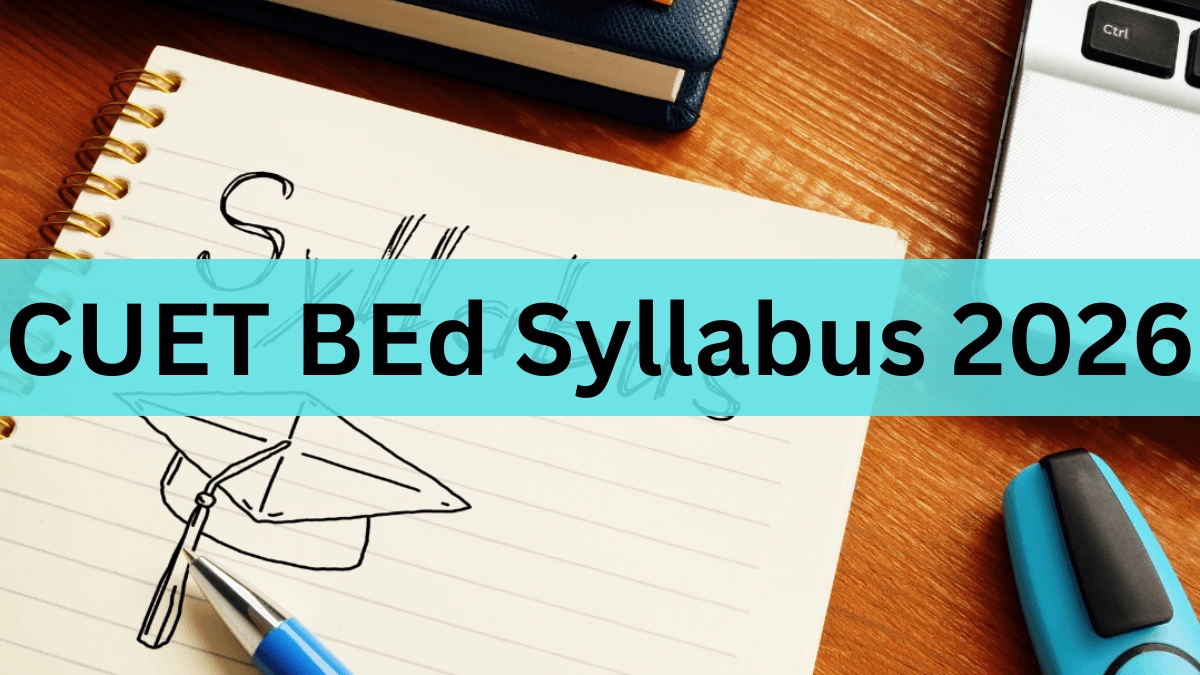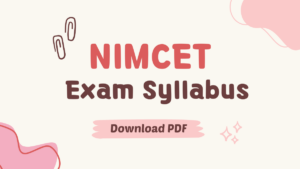Candidates aspiring to become teachers in schools need to pursue the BEd (Bachelor of Education) program. What could be better than to pursue the BEd course from one of the top universities that will provide you with an initial launchpad. This is where, the Common University Entrance Test (CUET) comes into picture. The CUET is held for admission to B.Ed program at top central, state and private universities. To ensure success in this exam, students must be aware of the CUET BEd syllabus. As the next CUET exam will be held in 2026, candidates must go through the latest CUET BEd syllabus 2026 provided on this page.
CUET BEd Syllabus
The Bachelor of Education (B.Ed) serves as a fundamental basis for individuals aiming to teach knowledge and values to future generations. The CUET B.Ed syllabus serves as an essential entrance exam, aimed at evaluating a candidate’s readiness and suitability for this esteemed profession. The CUET BEd syllabus is released every year by the CUET examination conducting body, i.e., National Testing Agency (NTA).
CUET BEd Syllabus 2026
The NTA will release the CUET BEd syllabus 2026 soon on its official website. However the past trends suggest that the upcoming CUET syllabus will remain similar to the previous BEd syllabus. As that syllabus is available, students should stop wasting time and begin their preparation using the available CUET B.Ed syllabus. To enhance clarity, the exam authority NTA has divided the CUET BEd syllabus into specific subject-wise BEd syllabi.
Decoding the CUET B.Ed Syllabus 2026
Candidates who have obtained their bachelor’s or master’s degree in various fields, such as humanities, social sciences, sciences, mathematics, or general studies, must participate in the corresponding BEd subject courses. Additionally, candidates need to study common topics for all streams like General Knowledge, Teaching Aptitude and Language Comprehension. The CUET BEd syllabus test the candidate in their subject knowledge as well as in their teaching skills.
CUET BEd Syllabus 2026 for Arts Students
Students who have pursued their qualifying education from the arts stream, they need to appear for the CUET General Aptitude Test (GAT) paper in order to take admission into the BEd program. Check CUET BEd syllabus 2026 for General Aptitude Test.
- General Knowledge
- Logical and Analytical Reasoning
- Current Affairs
- General Mental Ability
- Reasoning (Quantitative arithmetic/algebra/statistics/geometry/mensuration)
- Numerical Ability
CUET BEd Teaching Aptitude Syllabus 2026
Check the CUET Teaching Aptitude syllabus 2026 based on past exam papers below.
| Units | Detailed Syllabus |
| Two narratives/ newspaper reports about schools/teachers/ children/ Questions on data/information/analysis/issues | – Gender
– school access – teacher’s work – scores |
| Popular films and documentaries | related to
– Education – books – showing the struggles of girls’, tribals’ and Dalits |
| Science | – Based on observation of natural phenomenon
– famous Indian Scientists, women scientists, – Current information such as COVID, technology and programs in science |
| Mathematics | – sense of proportion, perspective, abilities
– Famous mathematicians, women mathematicians – Difficulties that children face while learning Mathematics |
| Arts, Music and Drama (Performing and Visual Arts) | – Academies of art teaching
– Benefits of practising art forms – Indian art and music traditions |
| Social Science | – Based on difficulties that children face in social sciences
– Details of subjects being taught – Nobel and other award winners for creating knowledge – Teachers in history: Buddha, Jain, construction of teachers in Upanishads. |
| Language and Literature | – famous stories, novels, and poems with reference in school under NCERT 6th to 12th syllabus.
– Biographies/autobiographies of famous women/tribals/Dalits with descriptions of their school experiences, teachers or a class. – Difficulties faced by children while learning poems or grammar |
CUET BEd Syllabus 2025 for Science Students
Students from the science domain can check the subject-wise latest CUET BEd syllabus below.
|
Subjects Name
|
Chapters
|
|
Botany
|
Phycology and Microbiology, Biomolecules and Cell Biology, Mycology and Phytopathology, Archegoniate, Anatomy and Angiosperms, Economic Botany, Genetics, Molecular Biology, Plant Ecology and Phytogeography, Plant Semantics, Reproductive Biology of Angiosperms, Plant Physiology, Plant Metabolism, Plant Biotechnology
|
|
Zoology
|
Cell Biology, Biochemistry, Molecular Biology, Ecology, Evolution, Biodiversity & Environment Conservation, Immunology, Genetics, Bio techniques, Vertebrates and Invertebrates, Developmental Biology, Biostatistics, Animal Physiology, Recombinant DNA technology
|
|
Chemistry
|
Physical Chemistry
Gaseous State, Liquid State, Ionic Equilibria, Solid State, Thermodynamics, Thermochemistry, Second Law, Third law of thermodynamics, Free Energy Functions, Partial molar quantities, Dilute solutions or Colligative Properties, Molecular Spectroscopy & Photochemistry, Chemical Kinetics, Catalysis, Surface chemistry, Phase Equilibria, Introduction to Quantum Chemistry, Conductance, Electrochemistry
Inorganic Chemistry
Atomic Structure, Periodicity of Elements, Chemical Bonding, Metallic bonding and Weak chemical forces, Oxidation-Reduction and general principle of metallurgy, Chemistry of s and p Block Elements, Noble Gases, Inorganic Polymers, Coordination Chemistry, Transition Elements, Lanthanides and Actinides, Bioinorganic Chemistry, Organometallic Compounds
Organic Chemistry
Basics of Organic Chemistry, Stereochemistry, Chemistry of Aliphatic Hydrocarbons, Carbon-Carbon sigma bonds, Carbon-Carbon pi-bonds, Cycloalkanes and Conformational Analysis, Aromatic Hydrocarbons, Chemistry of Halogenated Hydrocarbons, Alcohols, Phenols, Ethers and Epoxides, Carbonyl Compounds, Carboxylic Acids and their Derivatives, Sulphur containing compounds, Nitrogen Containing Functional Groups, Polynuclear Hydrocarbons, Heterocyclic Compounds, Alkaloids, Terpenes, Basic Principles of UV Spectroscopy, Basic principles of IR Spectroscopy, NMR (1 H and 13C NMR), Basic principles Mass Spectrometry
|
|
Physics
|
Electrostatics, Current Electricity, Magnetic Effects of Current and Magnetism, Electromagnetic Induction and Alternating Currents, Electromagnetic Waves, Optics, Dual Nature of Radiation and Matter, Atoms and Nuclei, Electronic Devices
|
|
Home Science
|
Work, livelihood and Career Nutrition, Food Science and Technology Human Development and Family Studies Fabric and Apparel Resource management Communication and Extension
|
|
Computer Science
|
Computational Thinking and Programming, Computer Networks, Database Management
|
CUET BEd Syllabus 2026 for Mathematics & Statistics
Check the latest CUET B.Ed Maths and statistics syllabus below.
|
Subjects
|
Syllabus Chapters
|
|
Mathematics
|
Relations and Functions – Relations and Functions, Inverse Trigonometric Functions Algebra – Matrices, Determinants Calculus – Continuity and Differentiability, Applications of Derivatives, Integrals, Applications of the Integrals, Differential Equations Vectors and Three-Dimensional Geometry – Vectors, Three-Dimensional Geometry Linear Programming – Linear Programming Probability – Probability
|
|
Statistics
|
Sequences and Series: Convergence of sequences of real numbers, Comparison, root and ratio
tests for convergence of series of real numbers. Differential Calculus: Limits, continuity and differentiability of functions of one and two variables. Rolle’s Theorem, mean value theorems, Taylor’s theorem, indeterminate forms, maxima and minima of functions of one and two variables. Integral Calculus: Fundamental theorems of integral calculus. Double and triple integrals, applications of definite integrals, arc lengths, areas and volumes. Matrices: Rank, inverse of a matrix. Systems of linear equations. Linear transformations, eigenvalues and eigenvectors. Cayley‐Hamilton theorem, symmetric, skew‐symmetric and orthogonal matrices. Differential Equations: Ordinary differential equations of the first order of the form y’ = f(x,y). Linear differential equations of the second order with constant coefficients. Descriptive Statistics and Probability: Measure of Central tendency, Measure of dispersion, skewness and Kurtosis, Elementary analysis of data. Axiomatic definition of probability and properties, conditional probability, multiplication rule. Theorem of total probability. Bayes’ theorem and independence of events. Random Variables: Probability mass function, probability density function and cumulative distribution functions, distribution of a function of a random variable. Mathematical expectation, moments and moment generating function. Chebyshev’s inequality. Standard Distributions: Binomial, negative binomial, geometric, Poisson, hyper- geometric, uniform, exponential, gamma, beta and normal distributions. Poisson and normal approximations of a binomial distribution. Chi-square distribution, t-distribution and F-distribution. Joint Distributions: Joint, marginal and conditional distributions. Distribution of functions of random variables. Product moments, correlation, simple linear regression. Limit Theorems: Weak law of large numbers. Central limit theorem (i.i.d. with finite variance case only). Estimation: Unbiasedness, consistency and efficiency of estimators, method of moments and method of maximum likelihood. Sufficiency, factorization theorem. Completeness, Rao‐ Blackwell and Lehmann‐Scheffe theorems, uniformly minimum variance unbiased estimators. Rao‐Cramer inequality. Confidence intervals for the parameters of univariate normal, two independent normal, and one parameter exponential distributions Testing of Hypotheses: Basic concepts, applications of Neyman‐Pearson Lemma for testing simple and composite hypotheses. Likelihood ratio tests. Sampling and Designs of Experiments: Simple random sampling, stratified sampling and Cluster sampling, One-way, two-way analysis of variance. CRD, RBD, LSD and 2² and 2³ factorial experiments. |
CUET BEd Syllabus 2026 for Humanities / Arts & Social Science
Candidates can check the CUET syllabus 2026 for BEd entrance exam for candidates form Arts/Humanities and social science streams below.
|
Subjects
|
Chapters
|
|
History
|
Ancient History of India (10000 BC to 1206 AD), Early Medieval India (750 AD- 1206 AD), Medieval History of India (1206-1707 AD), Modern History of India (1707 to 1947)
|
|
Political Science
|
Western Political Philosophy, Indian Political Thought, Political theory, International Relations, Indian Government and Politics, Comparative Government and Politics, Public Policies in India, General issues of contemporary relevance.
|
|
Geography
|
A). Physical Geography Geomorphology, Climatology, Oceanography, Biogeography, Physical Geography of India B). Human Geography Geographic Thought, Population Geography, Geography of Resources, Economic Geography, Human Geography of India C). Geographical Techniques Cartography, Surveying Techniques, Statistical Techniques, Remote Sensing and GIS
|
|
Economics
|
Micro Economics, Macro Economics, Money and Inflation, Consumption and Investment Function, Statistical Methods in Economics, Mathematical Methods in Economics, Indian Economy
|
|
Commerce
|
Micro Economics, Currency and Banking, Essential of Management, Office Management, Accounting, Business Organization, Statistical Methods, Public Finance, Business Law, Cost Accounting, Company law and Secretarial Practice, Selling and Advertising, Business Mathematics, Insurance Law and Accounts, Income Tax Law and Accounts, Contemporary Audit, Indian Economic Structure, Marketing, Practice and Finance, Macro- Economics, Trade of India, Applied & Business Statistics, Law and Practice of Banking, Development Banking, Quantitative Economics
|
|
Home Science
|
Food Science Home Management Textile Human Physiology Extension Education Adult Education
|
CUET B.Ed Language Syllabus 2026
Candidates appearing for CUET PG exam for admission to the Bachelor of Education program must also study language subjects as they will have to choose one language from which questions will be asked. Check the CUET BEd languages syllabus below.
|
Languages
|
Syllabus
|
|
Hindi
|
Period division and naming of Hindi literature History of Hindi literature Various genres and authors of Hindi literature Various forms of purpose based Hindi Hindi in Mass Media Indian poetics Hindi Grammar
|
|
English
|
History of English and Indian Literature Indian Writing in English\Literacy Terms and Figures of Speech Literacy Genres Comparative Literature and Translations Studies Literacy Criticism and Theory Awareness of Current Literacy Trends, Events, Awards etc Reading Comprehension
|
|
Sanskrit
|
History of Sanskrit Literature Sanskrit Grammar Sanskrit Poetics and Prosody Sanskrit Literacy Works
|











 CUET Commerce Syllabus 2026, Download Su...
CUET Commerce Syllabus 2026, Download Su...
 CUET PG Hindi Syllabus 2026, Download CU...
CUET PG Hindi Syllabus 2026, Download CU...
 NIMCET Syllabus 2026, Download Subject-w...
NIMCET Syllabus 2026, Download Subject-w...








